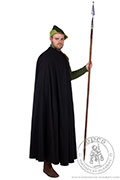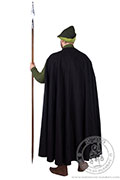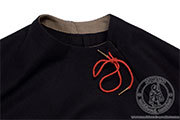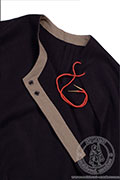If you wish to adjust your cookie preferences for this website, you can do so using your browser settings.
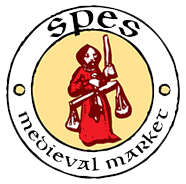


Category: Male clothing > outer garments
Medieval cloak made from three fourth of a circle
Medieval cloak made from three fourth of a circle
Century: XIII, XIV, XV| CODE | Material |
Standard
|
Price | |
| WMWR1416 | Wool | Hand-made | 290.00 EUR |
|
| WMWS1417 | Wool | Mixed | 250.00 EUR |
|
* Please write the extra wishes in the place 'additional information' at the end of the order.
** the price of a material button: 1,5 euro
the price of a moulded button: 1,5 euro
- You can choose a type of a cut-out after click 'buy'.
Lowest price in the last 30 days
See how to place an order for several people
The woolen medieval cloak is a completion of a medieval costume. This cloak is a perfect protection against wind, cold and rain. In former fashion, it works well both in a knight camp and during travels. Our medieval cloak is made out of 3/4 of a circle of warm, thick wool.
Medieval capes of this type do not have a lining. In the standard version, our medieval cloak is closed with a string. Wool provides a high hygroscopicity level – this medieval cloak can absorb a lot of moisture without feeling of it being wet. These features make it a perfect choice for any traveler or knight!
There is a wide range of colors to choose from for this medieval cloak. You can choose the color of the wool in this medieval cape as well as for the lace. Choose colors from the color chart and write proper codes later in the comment section while placing the order. If needed, we can also replace the lace with 6 tin buttons made of tin or any other model from our assortment (we use the tin ones if the client does not specify which buttons exactly they want).
Medieval cloak inspired by Bible
A medieval cloak of this type can be found for example in a miniature from the Winchester Bible from the 12th century. The work presents scenes from the life of King David. One of the presented characters is the king of England, Henry II Plantagenet, wearing a medieval cape of 3/4 of a circle. The Winchester Bible is stored in the cathedral library in Winchester.
What are the main features of our medieval cloak?
↪ cloak inspired by historical sources;↪ wool provides warm and protection against moisture;
↪ wide range of colors to choose from;
↪ option of modifications and adornments – make your own medieval cloak!;
↪ a 3/4 breadth ensures tight wrap, very important during cold evenings.
The origin of medieval cloak
Capes and cloaks were known to humankind even in ancient times which is proven by the example of a Pallium cloak. A medieval cloak, like most clothing from this period, emphasized the social status of a wearer. Often this type of garment had furry elements to make it warmer and more presentable.
When talking about medieval capes and cloaks, it is worth mentioning short examples which were usually intended especially for horse riding. Longer coats could be made of a whole circle, 3/4 of a circle or half of a circle. Medieval cloaks could be closed with a string, buttons, or a broche – often in a unique, ornamental design, made of expensive materials.
Medieval cloaks were used during important events in that time – both of church character and secular (in a form of ceremonial or coronational garments). It was also an essential part of a pilgrimage outfit.
The cloak word comes from an old-French cloque (cloche, cloke). It means a traveling cape and comes from Latin where clocca means a similar garment. Literally this word means a bell, because of the clothing’s design.





 Female Clothing
Female Clothing
 Accessories
Accessories Furniture
Furniture Tents
Tents Armament
Armament HMB Line
HMB Line Miscellaneous
Miscellaneous Rent
Rent In stock
In stock Special Offers
Special Offers Search
Search Your Account
Your Account About us
About us Sizing
Sizing How to buy
How to buy Blog
Blog Links
Links Events
Events


